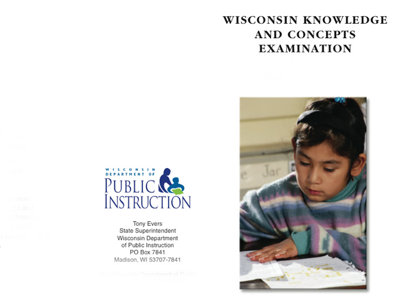If our tests stink, why aren’t we making them better? I tweeted that a few hours ago. So, you know I received today’s statement from the Dept. of Public Instruction with interest.
The statement updates us on Wisconsin’s work with a consortium of 30 states to develop the components of a new system of assessments that will lead to a transition to a “new generation of student tests.”
The process has been underway about a year so far to create a new assessments system based on the Common Core State Standards, which have been adopted by all but a small handful of states.
Wisconsin has adopted these national standards, which have been the subject of much discussion and some controversy thanks to the push and pull between forces that question what role the federal government ought to play in the traditionally state-focused education sector.
The DPI says the new system will be a “rigorous, balanced” means for tracking student progress and strengthening classroom instruction and academic interventions.
“We have been heavily involved in this effort since the beginning,” said state school superintendent Tony Evers in the statement. “Having just completed the work of our Next Generation Assessment Task Force, we were in a great position to know what the Wisconsin education community wanted from its assessments – and to know that pooling our resources with this particular consortium of states was a rare opportunity to achieve these goals cost-effectively.”
The tests would replace the WKCE exams that many seem to think are flawed. After a single year of taking those tests, Gov. Scott Walker decided schools that participate in the Milwaukee Parental Choice Program should again be exempt as of next year. Some voucher proponents say they’re not against assessments but that the WKCE tests are not the right measuring stick.
If these new tests turn out to be the kind of improvement in assessments that everyone is calling for, who could justify exempting tax-funded voucher schools from them?
One of the improvements in the new system, according to the DPI, is that it includes interim assessments to track student progress across the entire school year rather than via a single annual exam.
“It will do more than simply replace the state’s WKCE examinations, given annually to every student,” the DPI statement says. “It will also help educators, parents, and students themselves continuously monitor and improve learning. There is no such fully integrated system available today. The interim assessments will also help districts maximize resources by early identifying students who need either extra help or extra challenge – a key goal in Wisconsin’s use of the educational strategy called Response to Intervention (RtI).”
And because, for the first time, a majority of states will take assessment tests based on the same common core standards – already adopted by 42 states and two territories (and partially adopted by a 43rd state) – Wisconsin will be able to gauge how our kids are doing in comparison with the rest of the country.
The DPI statement says the new tests will go “beyond strictly multiple choice, paper-and-pencil testing, the central component of the new
assessment will be administered on a computer, automatically varying the difficulty of test-takers’ questions based on their previous responses.”
This is how the current MAP (Measures of Academic Progress) benchmark tests in math, reading, science and language usage work.
Another change is that a portion of a student’s score will be based on “performance tasks in the classroom,” creating, presumably, a more rounded and accurate look at students’ progress.
The new system is expected to be in place in time for the 2014-15 school year, which means we’re in for a few more years of WKCE tests.
The new system won’t cost more, according to Evers.
“Thanks to the combined efforts of the consortium states, the projected cost for the new assessments is similar to our current WKCE exams,” Evers said. “And yet, they represent the next generation in testing, coordinated with up-to-date, national standards – all part of taking students’ education to a new level and ensuring each child graduates ready for further education and the workforce.”
A test everyone can love? You’ll pardon my skepticism. But as always, I promise to meet it halfway with optimism, too.


 i evaluate to yes even if there's no image
i evaluate to yes even if there's no image  i evaluate to yes even if there's no image
i evaluate to yes even if there's no image  i evaluate to yes even if there's no image
i evaluate to yes even if there's no image  i evaluate to yes even if there's no image
i evaluate to yes even if there's no image  i evaluate to yes even if there's no image
i evaluate to yes even if there's no image  i evaluate to yes even if there's no image
i evaluate to yes even if there's no image 